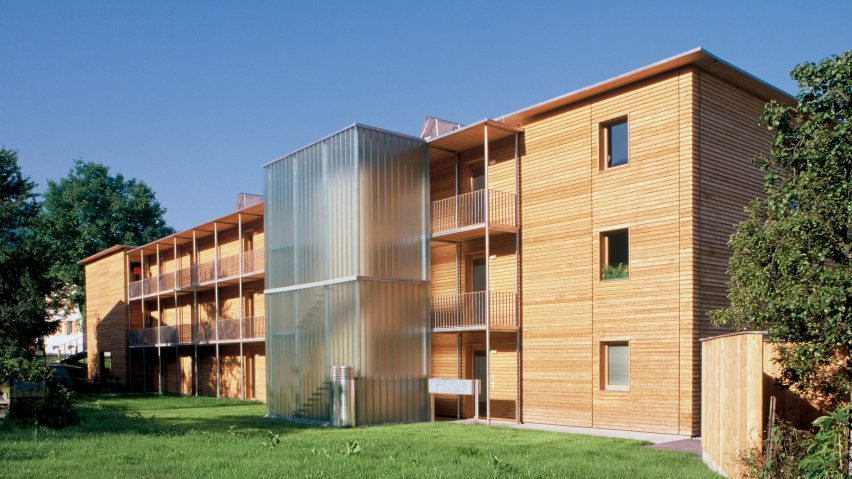The first of our Timber Revolution case studies looks at an innovative, early example of mass-timber multi-storey housing, designed by Austrian studio HK Architekten in the 1990s.
Named the Ölzbündt building, the housing development in Dornbirn, Austria, is an early example where mass-timber was used to create a large housing block. Built in 1997, it draws on the area's history of wood construction.
Its deceptively simple design nods to traditional houses in the local Vorarlberg area, which were clad with wooden shingles, but Ölzbündt represents a modern take on these historic buildings.
"The development of mass-timber construction began in our area 50 years ago," HK Architekten founder and CEO Hermann Kaufmann told Dezeen.
"We are almost half a century ahead of international developments, so it makes sense that this project was already constructed in mass timber 25 years ago," Kaufmann added.
"It was a research and development project, a showcase on the subject of multi-storey construction in wood."
Measuring almost 42 metres in length and nine metres in width, Ölzbündt holds twelve one- and two-bedroom apartments, as well as one single-family residential unit.
The three-storey apartment complex, which was constructed around a mass-timber frame, was designed as a prototype for developing a timber construction system that would be suitable for multi-storey residential buildings.
"For the Ölzbündt residential complex, we used a skeleton made of mass timber for the construction, because this is a standard and historically customary construction method in central Europe," Kaufmann said.
"We used timber-frame construction for the prefabricated wall elements," he added.
"As you can see, the Ölzbündt project is a mix. The advantage of mass-timber construction is that we only need a few supports for the entire building. This ensures flexibility for the future. It is a pure skeleton construction."
Ölzbündt was clad in larch, which the studio says emphasises the building's volume, and features a canopy roof to protect the facade from the weather.
"Bonded timber panels, three-layer panels, plywood and solid timber planking were employed according to their structural characteristics, weather resilience and even design criteria," the studio said.
Balconies made from slender steel struts with timber planking add additional exterior space and match the wooden facade of the building, which also features a contrasting staircase encased in a glass shell.
As mass-timber buildings are becoming more and more popular, we are increasingly seeing taller structures being built using the material.
Timber's popularity also ties into the growing interest in biophilic design by creating buildings that have a more natural feel than those built in concrete.
For HK Architekten, the Ölzbündt building is proof that timber is "the most sensible" material when it comes to creating buildings from prefabricated elements.
"The building teaches us that it makes sense to adapt construction methods to their functionality," Kaufmann said.
"So it makes sense to make the structure from mass timber to avoid load-bearing walls, which is a great advantage for flexibility. For the prefabricated wall elements, a timber frame construction is certainly the most sensible."
"The building also shows us that criticism of the longevity of wooden buildings is unfounded," Kaufmann added.
Ölzbündt was one of the first housing developments in Europe to reach Passivhaus standards and thanks to the heat-insulating properties of its outer walls, heating elements were not necessary.
"No more then 26 kWh/Btu per square meter per year is necessary since the building features individually adjustable ventilation, heat exchangers and uses residual energy efficiently," the studio said.
Hot water is generated by photovoltaic panels on the roof.
The photography is by Ignacio Martinez.
Timber Revolution
This article is part of Dezeen's Timber Revolution series, which explores the potential of mass timber and asks whether going back to wood as our primary construction material can lead the world to a more sustainable future.

